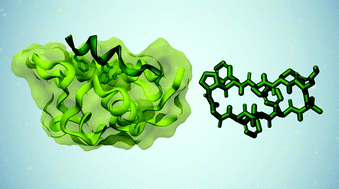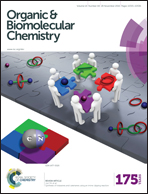Flexibility is important for inhibition of the MDM2/p53 protein–protein interaction by cyclic β-hairpins†
Abstract
Protein–protein interactions that have large, flat and featureless binding sites are difficult drug targets. In the development of their modulators conventional drug discovery strategies are often unsuccessful. Gaining a detailed understanding of the binding mode of protein–protein interaction inhibitors is therefore of vast importance for their future pharmaceutical use. The MDM2/p53 protein pair is a highly promising target for cancer treatment. Disruption of the protein complex using p53 α-helix mimetics has been shown to be a successful strategy to control p53 activity. To gain further insight into the binding of inhibitors to MDM2, the flexibility of four cyclic β-hairpins that act as α-helical mimetics and potential MDM2/p53 interaction inhibitors was investigated in relation to their inhibitory activity. MDM2-binding of the mimetics was determined using fluorescence polarization and surface plasmon resonance assays, whereas their conformation and dynamics in solution was described by the combined experimental and computational NAMFIS analysis. Molecular flexibility was shown to be important for the activity of the cyclic β-hairpin based MDM2 inhibitors.



 Please wait while we load your content...
Please wait while we load your content...